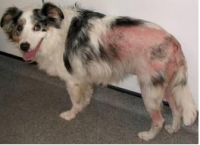Flea Allergies in Dogs
Fleas are annoying pests that bite our pets and us feeding on our blood. They carry diseases that can make us sick and the saliva in their bites can set off an allergic reaction. An allergy to flea bites causes flea allergy dermatitis (FAD). This is a fancy term for the skin problems resulting from the allergic reaction to flea bites. Dogs, cats, and humans can all react, but the way it shows up on the skin looks different. The hallmark in all of them is that it is very itchy. FAD is the most common skin disease in pets in the world.
Incidence
It is estimated that up to 50% of the dogs with fleas will develop FAD. If dogs are not allergic to the bites, they may only scratch slightly even if they have many fleas. The amount of scratching is not an indication of how many fleas a dog has.
If the dog is allergic, one flea bite can cause enough itchiness to make the dog scratch constantly. Dogs don’t usually develop the allergic reaction until they are about a year old, and it’s rare before they are six months old.
Signs
The most common sign in dogs is intense itching. These dogs spend much of their time scratching and biting and they develop crusty bumps. They also damage their skin due to the excessive scratching leading to skin infections, hair loss, redness, and other skin changes.
Crusty bumps in the umbilical fold are a classic sign you may see with FAD. This is seen more in male dogs.The skin changes are seen on the back half of the dog: near the base of the tail, along the lower back, and the inside and backs of the thighs. Skin problems limited to the back half of the dog are specific to FAD. No other itchy condition in dogs only shows problems on the back half. This is very helpful in deciding whether the problem is FAD.
Diagnostics
Often the biggest challenge veterinarians have is convincing the dog parent that the condition is due to fleas. Too often, you don’t find fleas on a dog that is allergic to them. The dog is biting or scratching them off so rapidly, you don’t see either fleas or flea dirt on the dog.The dog parent may also be treating the dog for fleas. Unfortunately, at times the treatment isn’t as successful as it needs to be. Fleas keep biting your dog and the allergies keep going. However, you’re thinking you’ve done everything you should, so fleas can’t be causing your dog’s skin problems!
To complicate things further, your dog may have other allergies or conditions that also cause itchy skin. You may see sores on other parts of the body or different signs. In these cases, you may need to treat for fleas and see how much relief your dog has. If he is still itchy, you will need to look for other causes.The treatment is to control fleas well. You need to treat for three months to get fleas completely under control and to stop the allergic reactions. You should use one of the newer flea products that are more effective. Bathing and swimming can reduce the effectiveness. In that case, an oral product that kills both adults and immature stages is a better choice.
Treat all pets in the house and treat the house to reduce the number of immature stages. Read Controlling Fleas and Understanding Fleas. They will help you understand what needs to be done, and why it is important.
Your veterinarian can give you medicine to help your dog be more comfortable while you are working on the fleas. She can also treat any skin infections that may be making it worse.
Summary
Flea allergies make your dog miserable. On the one hand, once you get rid of the fleas, the problem is solved. However, on the other hand, it’s a lot of work, time, and expense to get rid of them. Keep at it so you get the fleas under control as quickly as possible and your dog is comfortable. Then continue treating your dog year-round so that he never has to go through it again!
All articles are reviewed and maintained by whiskerDocs team of veterinary experts.




